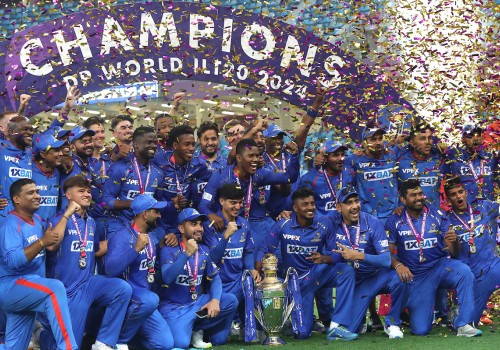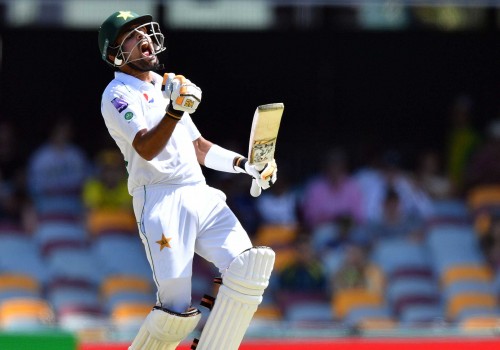One-day cricket – the entertainment evolution
Regulatory fine tuning
After the last World Cup, the ICC relaxed the rules related to fielding restrictions to protect bowlers, described by the body’s chief executive David Richardson as, “On a hiding to nothing.” Added to which, as of the end of Q3-2017 there are now restrictions on the size of bats players can use.
“The permitted size of the bat is now defined, with the width and length unchanged, but with added restrictions on the thickness of the edges (40mm) and the overall depth (67mm). Umpires will be issued with a new bat gauge, which they can use to check a bat’s.”
Regulators at the ICC, believe that this last piece of fine tuning will become the balancing factor for the ODI format, in that the game will favour both aggressive batting and bowling in equal measure. In other words, the change will facilitate a combination of the fast scoring rate prevalent in T20; together with the aggressive bowling of Test cricket. There is certainly no general desire for more radical revisions that might further empower bowlers, for instance increasing their allocation to more than ten overs in an innings.
Improving performance
Any impact Twenty20 might have had on ODI cricket proved largely undetectable for many years. In 2002, the year prior to the launch of T20 cricket, the average run rate in ODI games stood at 4.94 an over; a decade down the road it had only reached 5.05. However, 2012 saw the introduction of batting-friendly rule changes that started to translate into a leap in ODI run rates after roughly twelve months. Climbing to 5.50 per over in 2015 and achieving much the same level in the following year, even at the post-implementation stage of what were considerably more congenial bowler laws. Here there are standout performers on the big stage which other contenders have to chase, with India’s run rate at 5.77 and England’s a whopping 6.26.
A side’s chances of successfully chasing down lofty run targets have improved considerably since the start of 2013. According to statistician Ric Finlay, totals of between 300 and 324 have been overtaken in 27 percent of cases, compared with 17 percent between 2001 and 2013. Indicating that confidence, power and skill appear to have a far greater impact on the final score as opposed to whether or not the extra fielder may now be placed outside the 30-yard circle.
In the first World Cup a six was launched on average every 344 balls or once an innings, if spectators were lucky. Rolling forward to the most recent World Cup, the crowd were able to wave their appropriately marked cards in appreciation of a six every 99 balls on average, roughly once an hour. However, even that has been surpassed on a team basis with the currently top two ranked ODI sides, England and India, hitting a boundary every 8.5 and 9.6 balls respectively.
Impact rule changes
What may sound like a relatively subtle, I use the adjective loosely, change was the reduction In October 2012 of previously a maximum of five fielders that could be stationed on the boundary in the middle overs [11- 40], to four. Undoubtedly, this scenario represents the main problem that has to be solved by today’s one-day international captains.
Australian batsman Aaron Finch observed:
“That’s the big thing that I think makes a huge difference. The guys have confidence that they’re not hitting over blokes’ heads on the boundary anymore, they’re just hitting to an empty area of the ground.”
The fielding update has not just altered the pace of a game, but its structure. Certainly it has had an incremental impact on average scores. Yet the main conclusion is really that a side has 50 overs and effectively must use all of them well. Especially when increased scoring rates now make each ball more crucial than ever. The fact that it is now essential for teams to bat out their full allocation of overs, can only be good for the game from the spectator entertainment perspective.
The statisticians appear to be pretty much in consensus over the principle that if a side bats out a full complement of overs, it will automatically win five matches out of eight. Teams that batted through the full 50 overs, regardless of the score which they physically made, fundamentally won 62 per cent of their matches, if tied and no result games were excluded. Teams bowled out within less than 50 overs, regardless of how many runs they scored, went on to win just 17.5 per cent.
World Cup approaching
So what should aspiring ICC Cricket World Cup 2019 champions aim for at crucial stages of a match?
First 10 overs (1st Powerplay)
It’s certainly the case that a team cannot win an ODI in the first 10 overs. However, In what might be logically referred to as new-age-one-day cricket, the first 10 overs seem to carry less importance in terms of scoring runs but much greater emphasis on building a platform. The average 1st Powerplay score since April 2015 is around 50, and in some cases like Australia and New Zealand up to 55, nevertheless, it is fair to say that most good sides do not necessarily need a fast start to build a huge total.
But with two fielders only permitted outside the 30 yard fielding restriction area, it is also a massively tempting period for batsmen, good bowlers of course can equally snap up the wickets.
Yet it is what you as a team do or don’t do in those first ten overs which can exert a huge influence on the rest of the innings. Going a couple of wickets down during the Powerplay, does not seem like the end of the world, correct? No it is not, but losing those wickets has knocked around 40 runs off the total that might have been achieved, had the openers still been at the crease. Lose three wickets and there is an increased likelihood of being bowled out for under 200 as opposed to reaching at least 250, which then becomes a slippery slope.
Overs 11 to 40 (The 2nd Powerplay)
No more than four (4) fieldsmen are permitted outside the 30 yard fielding restriction area. In an innings of 50 overs, the so called 2nd Powerplay resides within overs 11 to 40 inclusive
Teetering on the 11th over and has the time has come for a batting Powerplay? Now what might comprise a decent upshot out of these middle overs? Would the best tactics be to keep wickets in hand and allow the scoreboard to tick over? Or conversely go for the big hits and risk losing a couple of batsmen who have played themselves in and are seeing the white conker like a football?
Speaking statistically again and as a caveat anything quoted to date that begins with the ‘S’ word could change overnight according to performance, the average yield from this stage of the game should be at least 160 runs. Nonetheless, the number of wickets lost has a major impact on whether this will be good enough in the final analysis.
Returning to comparisons over the last three years England and India have averaged 180 and 167 respectively in this section of the game.
My original conclusion was that the last 10 overs generally constituted the most productive stage of an innings, therefore in my eyes ensuring that wickets were kept in hand for the final push would be vital. However, making a mockery of any timid captaincy ambitions I might have had, I am reliably informed that without exception these days team strategists, playing under the revised regulations, when posed the question, “Runs versus wickets in hand?” would elect to, “Take the runs every time!” In other words, fortune generally smiles on the brassily adventurous who boldly go where…..etc, etc.
The last 10 overs (The 3rd Powerplay)
Usually an enormous amount happens during this period of the game. Sides score virtually 30 percent of their runs as well as losing 40 percent of their wickets, the crowd loves it and the players’ stress levels are under duress from all sides.
Getting on top of this stretch of overs is essential; run rates of 10, 12 or even 15 an over are no longer out of the question. However, the odds have been evened up in that no more the five fielders are allowed outside the 30 yard fielding restriction area.
Back to statistics, the average number of runs scored in the last 10 overs of a first innings is 76; something that specific must be equally prone to a shift or two surely? For example both England and India’s average scores (84 and 79) have eclipsed this since 2015. Yet within this strange number resides a plethora of complexities. How well a team does in the final 10 overs is very much dependent, on what sort of condition the side finds itself in when they enter the fray.
Entering the death overs with more than five wickets down could well indicate you’re in a tad of trouble. They say the difference between four and six wickets down at 40 overs is about 20 runs, on average. Although, so called, tail-enders have increasingly had their moments, with ODI team coaches constantly in search of ever extending batting depth. However, the common denominator for success is wickets in hand, which while not an absolute guarantee depending on the oppositions bowling containment skills, certainly increases the chance-factor in favour.
At the end of the day
Well what is a good score? Perhaps safer to start off with what isn’t a good score and work up the ladder! A total of 200 gives any team a 2.5 percent chance of victory. What was once considered a par score of 250, these days only wins you the game in 30 percent of cases and that figure is on the wane. A score of 300 is still regarded as pretty decent, but nowhere near as insurmountable as it once was, although now sliding statistics indicate a team can win 88 percent of the time if they achieve it. Knock 359 and above then there is 99.9 percent winning probability. And then of course there are record busting performances. England made a colossal 481 for 6 in 50 overs against Australia in June 2018 eclipsing their previous record against Pakistan, also reached and broken at the home side’s same Trent Bridge Test ground, of 444 back in 2016. Worth remembering, the ICC Cricket World Cup is to be played in England and Wales including Trent Bridge as one of the venues.
Then of course there is the specifically magic number of 264, which represents the point at which the match is perfectly even with a 50/50 chance of either side winning, that mysterious stat has stood for a while and might just be heading upwards.
Still it is surprising how many of the old maxims for success still hold good! For instance doubling up a team’s score after 30 – 31 overs still seems to more or less work. Also, seeing off the new ball(s) remains as important in 2018, as it was when the ODI train first left the station back in ‘75. Yet for fielding captains as well as batting captains, the modern game has become more of a juggling act than ever before. But for spectators the ICC tweaks have culminated in the prospect of a mouthwatering World Cup.
Expat Sport’s Mac McTiernan review’s the evolution of one-day international cricket and the entertainment impact on next year’s World Cup which promises to be an exciting affair.
The International Cricket Council (ICC) has been conscious of criticism that the rules of ODI cricket have changed all too frequently since 2005, for some time now. Exhibiting sound judgement, they have concluded that enough is enough and there is no merit in further tweaks to the rules. That is with a single exception, there is always one as they say; the cricket ball or more accurately the number of balls in play. ICC’s preference is to revert to using one ball for the duration of each innings, as opposed to a different ball from each end, should a sufficiently durable product become available.




